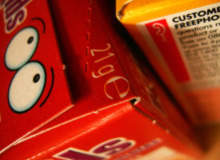
The call for environmentally friendly packaging can be heard throughout the food industry. Drinks or food cartons that are made from recycled material or managed forests where raw material is replaced are providing a sustainable option and offering companies the opportunity to reduce their carbon footprint.
A new study found that cartons topped their packaging competitors in the green stakes. A Europe-wide life-cycle assessment of cartons, food metal cans, glass jars and pouches found that carton packaging can save CO2 emissions and reduce fossil resource use by up to 60%, according to SIG Combibloc, which commissioned the Institute for Energy and Environmental Research to undertake the study.
Supermarkets’ favourite
One area where opportunities exist to use recycled material and lighter cartonboard is in the ready-meals market. The watchstrap-style cartonboard sleeve for ready-meals is in high demand by supermarkets for environmental and cost benefits. In addition, consumers like it because the contents are visible.
Kliklok and cartonboard producer Korsnäs of Sweden are running automatic sleeving trials using Korsnäs Supreme 250 micron/200g/m² board where typically a 400 micron/250g/m² is used. Kliklok spokesperson Michelle Tatum says that this formula offers a cost-efficient solution.
“The feedback so far is that Kliklok’s Certiwrap wraparound carton can comfortably and efficiently handle this lightweight board at speeds of up to 150 sleeves a minute,” Tatum says.

US Tariffs are shifting - will you react or anticipate?
Don’t let policy changes catch you off guard. Stay proactive with real-time data and expert analysis.
By GlobalDataThe company’s patented rotary carton feeder makes this possible. The technology pulls rather than sweeps the carton out of the hopper and transfers it into the flight chains in the same direction as the carton travel. In doing so, it gently pulls the carton into shape, reducing damage to the pack and enabling recycled and lighter weight board to be run with confidence – for less wastage, better productivity and higher profit.
“This is great news for food producers who are increasingly obliged to combine increased production with reduced packaging costs, and avoids negative environmental impacts associated with using traditional heavier cartonboard,” says Tatum.
The company’s Certiwrap wraparound cartoners have been proven to handle a wide range of ‘economically shaped’ sleeves, with optional features for product retention, tamper evidence and upright shelf-ready display.
The company recently had a commission from Heinz to launch microwaveable Snap Pots using an innovative wraparound pack style for baked beans and spaghetti hoops. Heinz chose the Certiwrap C150 to wrap a printed cartonboard sleeve around the plastics four-pot pack. The carton enables instant product recognition, and its open design allows easy consumer viewing and accessibility. The C150 also offers Heinz easy size-changing and low maintenance.
Shape matters
In the world of packaging, shape matters and is a meaningful part of the message.
Design has to be used innovatively and work hard to express key brand traits and personality. With regard to environmental impact, overall weight and pack material are important elements.
Ian Webb, Webb Scarlett deVlam founder and managing director, says that getting more for less has to be an imperative in today’s competitive environment.
“It’s clever to have an own-able pack,” says Webb. “A focused design strategy can build premium quality into a product, to raise its price-point and the profit margin.”
He adds that the cube-shaped wine box on the US market is a good example of a package that differs from the competition.
Design value
Overall weight and the pack material are the main environmental impact issues of a packaging system for ambient food products such as soups and tomato products. As the food and retail industry is globalised, this life-cycle assessment took a Europe-wide approach and factored in the ‘considerable’ variation found in national recycling rates.
The results appear to show carton packaging performs ‘significantly better than the assessed packaging alternatives in almost all environment-related impact categories’, according to Michael Hecker, head of group environment, health and safety at SIG Combibloc.
Bob Houghton, head of marketing at cartons manufacturer Chesapeake, says good design and value engineering has enabled alternative ways of packaging products to reduce the amount of waste and in some cases cut out the use of plastics. Because a mono-material packaging specification is easier to recycle, Chesapeake is even offering food packaging alternatives that dispense with PET thermoforming.
“The design team, working together with marketing and brand owners, has created innovative products with shelf stand-out while reducing the amount of packaging going to landfill,” says Houghton.
He cites as a good example the Green & Blacks ‘bag-shaped carton’ by Chesapeake’s Bradford factory and the London-based Pearl Fisher design agency.
The carton was printed using six colours plus a special drip-off varnish process, combining registered high gloss and matt varnishes.
Chesapeake’s novel DualPack is made from one piece of board with two compartments, which, if necessary, can be easily split by the user by adding perforations to the side panels. There is a neat tuck-top design and a tactile flip-top that produces a distinctive ‘click’ when the lid is opened or closed. For the healthcare market, the pack can be adapted to contain a blister card for tablets. The pack is also suitable for confectionery and toiletries.
The search for green packaging is shielding the carton manufacturers from the worst of the economic downturn and as an appealing proposition and format to consumers, the future of cartons could be a very bright green.
A version of this article first appeared in our sister publication Packaging Today.



